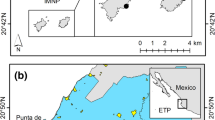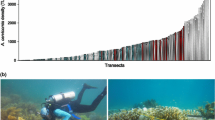Abstract
The impact of sedimentation on coral–algal interactions was studied by monitoring tissue mortality and radial growth in two coral species, Colpophyllia natans and Siderastrea siderea, over a continuum of sediment input intensities. This study sets out to investigate (1) whether sedimentation can facilitate algal overgrowth of corals and (2) whether this was a significant cause of coral mortality. Over a 15-month period, 198 coral colonies were tagged and photographed at six sites along two replicate gradients of sediment input, spanning high inputs near river mouths to low inputs at exposed headlands. Photographs were taken so that they covered the interface between colonies and algae. Radial growth was measured along colony edges in contact with algae and unaffected by tissue loss from causes other than competition with algae. To establish whether algal overgrowth was a significant cause of coral mortality, tissue mortality on the colony surface area visible in the photographs was related to different causes, including sediment smothering, disease, and algal overgrowth. Radial growth became negative with increasing proximity to river mouths in C. natans and remained negative or close to zero throughout the gradients in S. siderea, overall suggesting that sedimentation can facilitate algal overgrowth on corals. However, the analysis of tissue mortality revealed that algal overgrowth was a relatively minor cause of tissue loss. In contrast, the most important cause of coral mortality in relation to sedimentation was from sediment smothering, probably during intense episodes of deposition associated with heavy rainfall. We conclude that sedimentation may lead to reef degradation by causing coral mortality through sediment smothering and burial, and then by suppressing the regrowth of surviving adult colonies through increased competition with algae.







Similar content being viewed by others
References
Aller RC, Dodge RE (1974) Animal–sediment relations in a tropical lagoon—Discovery Bay, Jamaica. J Mar Res 32:209–232
Babcock RC, Davies P (1991) Effects of sedimentation on settlement of Acropora millepora. Coral Reefs 9:205–208
Belliveau SA, Paul VJ (2002) Effects of herbivory and nutrients on the early colonization of crustose coralline and fleshy algae. Mar Ecol Prog Ser 232:105–114
Birkeland C (1977) The importance of rates of biomass accumulation in early successional stages of benthic communities. Proc 3rd Int Coral Reef Symp 1:15–21
Blomqvist S, Kofoed C (1981) Sediment trapping—a subaquatic in situ experiment. Limnol Oceanogr 26:585–590
Brown BE, Howard LS (1985) Assessing the effects of “stress” on reef corals. Adv Mar Biol 22:1–63
Burke L, Selig E, Spalding M (2002) Reefs at risk in southeast Asia. World Resources Institute, Cambridge, 72 pp
Cortes JN, Risk MJ (1985) A reef under siltation stress: Cahuita, Costa Rica. Bull Mar Sci 36:339–356
D’Antonio CM (1986) Role of sand in the domination of hard substrata by the intertidal alga Rhodomela larix. Mar Ecol Prog Ser 27:263–275
Dustan P (1977) Vitality of reef coral populations off Key Largo, Florida: recruitment and mortality. Environ Geol 2:51–58
Dustan P (1994) Developing methods for assessing coral reef vitality: a tale of two scales. In: Ginsburg RN (ed) Proc Colloquium on Global Aspects of Coral Reefs, University of Miami, pp 38–45
Fabricius K, De’ath G (2001) Environmental factors associated with the spatial distribution of crustose coralline algae on the Great Barrier Reef. Coral Reefs 19:303–309
Gilmour J (1999) Experimental investigation into the effects of suspended sediment on fertilisation, larval survival and settlement in a scleractinian coral. Mar Biol 135:451–462
Ginsburg RN (1994) Proceedings of the colloquium on global aspects of coral reefs: health, hazards, and history. University of Miami, Miami, USA
Ginsburg RN, Gischler E, Kiene WE (2001) Partial mortality of massive reef-building corals: an index of patch reef condition, Florida Reef Tract. Bull Mar Sci 69:1149–1173
Hodgson G (1990) Sediment and the settlement of larvae of the reef coral Pocillopora damicornis. Coral Reefs 9:41–43
Hubbard DK (1986) Sedimentation as a control of reef development: St Croix, U.S.V.I. Coral Reefs 5:117–125
Hughes TP (1994) Catastrophes, phase-shifts, and large-scale degradation of a Caribbean coral-reef. Science 265:1547–1551
Hunte W, Wittenberg M (1992) Effects of eutrophication and sedimentation on juvenile corals. II. Settlement. Mar Biol 114:625–631
Jackson JBC (1977) Competition on marine hard substrata: the adaptative significance of solitary and colonial strategies. Am Nat 111:743–767
Jompa J, McCook (2002a) Effects of competition and herbivory on interactions between a hard coral and a brown alga. J Exp Mar Biol Ecol 271:25–39
Jompa J, McCook (2002b) The effects of nutrients and herbivory on competition between a hard coral (Porites cylindrica) and a brown alga (Lobophora variegata). Limnol Oceanogr 47:527–538
Kendrick GA (1991) Recruitment of coralline crusts and filamentous turf algae in the Galapagos archipelago: effects of simulated scour, erosion and accretion. J Exp Mar Biol Ecol 147:47–63
Klumpp DW, McKinnon AD (1989) Temporal and spatial patterns in the primary production of a coral reef epilithic algal community. J Exp Mar Biol Ecol 131:1–22
Kojis BL, Quinn NJ (1984) Seasonal and depth variation in fecundity of Acropora palifera at two reefs in Papua New Guinea. Coral Reefs 3:165–172
Lang JC (1973) Interspecific aggression by scleractinian corals. 2. Why the race is only to the swift. Bull Mar Sci 23:260–279
Loya Y (1976) Effects of water turbidity and sedimentation on the community structure of Puerto Rican corals. Bull Mar Sci 26:450–466
Meesters EH, Bos A, Gast GJ (1992) Effects of sedimentation and lesion position on coral tissue regeneration. Proc 7th Int Coral Reef Symp 2:681–688
McCook LJ (2001) Competition between corals and algal turfs along a gradient of terrestrial influence in the nearshore central Great Barrier Reef. Coral Reefs 19:419–425
Morelock J, Grove K, Hernandez M (1983) Oceanography and patterns of shelf sediments, Mayaguez, Puerto Rico. J Sediment Petrol 53:371–381
Nugues MM, Roberts CM (2003) Partial mortality in massive reef corals as an indicator of sediment stress on coral reefs. Mar Pollut Bull 46:314–323
Philipp E, Fabricius K (2003) Photophysiological stress in scleractinian corals in response to short-term sedimentation. J Exp Mar Biol Ecol 287:57–78
Potts DC (1977) Suppression of coral populations by filamentous algae within damselfish territories. J Exp Mar Biol Ecol 28:207–216
Purcell SW (1997) Quantifying organic content of material from coral reefs. In: Proc Natl Conf The Great Barrier Reef, science, Use and Management, Great Barrier Reef Marine Park Authority, Townsville, Rep 2, pp 61–66
Richardson CA, Dustan P, Lang JC (1979) Maintenance of living space by sweeper tentacles of Montastrea cavernosa, a Caribbean reef coral. Mar Biol 55:181–186
Riegl B (1995) Effects of sand deposition on scleractinian and alcyonacean corals. Mar Biol 121:517–526
Riegl B, Branch GM (1995) Effects of sediment on the energy budgets of four scleractinian (Bourne 1990) and alcyonacean (Lamouroux 1816) corals. J Exp Mar Biol Ecol 186:259–275
Rogers CS (1979) The effect of shading on coral reef structure and function. J Exp Mar Ecol Biol 41:269–288
Rogers CS (1990) Responses to coral reefs and reef organisms to sedimentation. Mar Ecol Prog Ser 62:185–202
Roy KJ, Smith SV (1971) Sedimentation and coral reef development in turbid water: Fanning Lagoon. Pac Sci 25:234–248
Seapy RR, Littler MM (1982) Population and species diversity fluctuations in a rocky intertidal community after severe aerial exposure and sediment burial. Mar Biol 71:87–96
Sladek Nowlis J, Roberts CM, Smith AH, Siirila E (1997) Human-enhanced impacts of a tropical storm on nearshore coral reefs. Ambio 26:515–521
Sousa WP, Schroeter SC, Gaines SD (1981) Latitudinal variation in intertidal algal community structure: the influence of grazing and vegetative propagation. Oecologia 48:297–307
Stafford-Smith MG (1993) Sediment rejection efficiency of 22 species of Australian scleractinian corals. Mar Biol 115:229–243
Steneck RS (1988) Herbivory on coral reefs: a synthesis. Proc 6th Int Coral Reef Symp 1:37–49
Steneck RS (1997) Crustose corallines, other functional groups, herbivores and sediments: complex interactions along reef productivity gradients. Proc 8th Int Coral Reef Symp 1:695–700
Stewart JG (1989) Establishment, persistence and dominance of Corallina (Rhodophyta) in algal turf. J Phycol 25:436–446
Szmant AM (1991) Sexual reproduction by the Caribbean reef corals Montastrea annularis and M. cavernosa. Mar Ecol Prog Ser 74:13–25
Te FT (1992) Response to higher sediment loads by Pocillopora damicornis planulae. Coral Reefs 11:131–134
Umar MJ, McCook LJ, Price IR (1998) Effects of sediment deposition on the seaweed Sargassum on a fringing coral reef. Coral Reefs 17:169–177
Walker DI, Ormond RFG (1982) Coral death from sewage and phosphate pollution at Aqaba, Red Sea. Mar Pollut Bull 13:21–25
Wanders JBW (1977) The role of benthic algae in the shallow reef of Curaçao (Netherlands Antilles). III: The significance of grazing. Aquat Bot 3:357–390
Wesseling I, Uychiaoco AJ, Aliño PM, Aurin T, Vermaat JE (1999) Damage and recovery of four Philippine corals from short-term sediment burial. Mar Ecol Prog Ser 176:11–15
Wilkinson C (ed) (2000) Status of coral reefs of the world: 2000. Australian Institute of Marine Science, Townsville, Australia, 364 pp
Yentsch CS, Yentsch CM, Cullen JJ, Lapointe B, Phinney DA, Yentsch SW (2002) Sunlight and water transparency: cornerstones in coral research. J Exp Mar Biol Ecol 268:171–183
Acknowledgements
We thank the St. Lucia Department of Fisheries, Soufrière Marine Management Area, Soufrière Foundation, and Scuba St. Lucia for their continuing support of our work. We much appreciate the help and involvement of staff from these organizations including Horace Walters, Sarah George, Dawn Pierre-Nathaniel, Susannah Scott, Kai Wulf, and Karyn and Michael Allard. Thanks are also due to Roger Malone, Daniel Nugues, Randolph Nicholas, Tessa McGarry, Chris Schelten, Annalie Morris, Rachel Miller, and Douane Joseph for assistance with field work, Allan Smith for technical assistance, and Jaap van der Meer for help with statistical analyses. The comments of Evan Edinger and an anonymous reviewer greatly improved the manuscript. This research was supported by grants from the UK Darwin Initiative and NERC secured by C.R.
Author information
Authors and Affiliations
Corresponding author
Rights and permissions
About this article
Cite this article
Nugues, M.M., Roberts, C.M. Coral mortality and interaction with algae in relation to sedimentation. Coral Reefs 22, 507–516 (2003). https://doi.org/10.1007/s00338-003-0338-x
Received:
Accepted:
Published:
Issue Date:
DOI: https://doi.org/10.1007/s00338-003-0338-x




